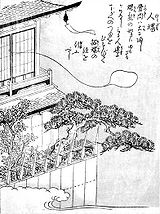- Hitodama
-
Hitodama (人魂, "human soul") are believed in Japanese folklore to be the souls of the newly dead taking form as mysterious fiery apparitions. The word hitodama is a combination of the Japanese words hito, meaning "human", and tama (short for tamashii), meaning "soul". These flames supposedly appear as pale blue or sometimes green spheres with long tails, and they are believed to be tricksters originating from fluorescent gases that can sometimes be seen above human graves.
Contents
In folklore
Hitodama are usually said to be found near graveyards and in gloomy forests in summer time, where they are said to live. They are allegedly sometimes seen close to a dying person as an apparition of the soul leaving the body before going to the other side. Most hitodama fade away or fall to the ground shortly after being spotted.
Among tricks they are believed to play on people is leading travelers off track, causing them to become lost. Some Japanese myths consider hitodama a trick of the kitsune, employing their "fox-fire" (kitsune-bi) to lead travelers astray.
Ghostly fires in Japan may also be called onibi (鬼火, "demon fire"). In Chinese they are called guǐ-huǒ (Pinyin) or gwäe-fo (Cantonese). Hitodama is the Japanese counterpart to the English "Will o' the wisp".
In popular culture
- In the manga and anime Dragon Ball Z, hitodama are seen frequently as Son Goku (and many other characters) traverse through "The Otherworld" and Hell.
- The Tecmo horror series Fatal Frame shows hitodama being released from spirits that the player manages to successfully exorcise.
- Hitodama is an ally of the main character Kinu Himuro 氷室 キヌ (Himuro Kinu) in the Ghost Sweeper Mikami anime and manga.
- The characters Youmu Konpaku and Yuyuko Saigyōji in the Touhou Project computer games are accompianied by hitodama. Youmu is described as a half-ghost, with her ghostly half residing outside of her human body and taking the shape of a large hitodama; whereas Yuyuko, a ghost princess, is usually seen with several small hitodama.
- In the series Inuyasha the re-animated priestess, Kikyo, is sustained by Hitodama which are harvested for her by special "soul carrier" demons.
- They are usually used as face faults in many anime, usually indicating depression.
- In the anime Ghost Hunt, hitodama (onibi) are often seen by the protagonist Mai in her dream visions.
- In the anime GeGeGe no Kitaro, hitodama are seen leaving via mouths of humans, usually after an antagonist yokai strikes them or uses a power to take their souls.
- In Soul Eater the souls of defeated characters are depicted as Hitodama
- The Pokémon Chandelure, Lampent, and Litwick are based on hitodama.
See also
- Ball lightning
- Anchimayen
- Luciola
- Naga fireballs
- Orb
- Spontaneous human combustion
- St. Elmo's Fire
- Will o' the wisp
Sources
Categories:- Ghosts
- Japanese legendary creatures
Wikimedia Foundation. 2010.

